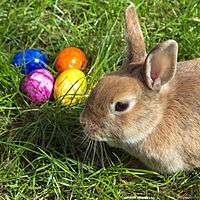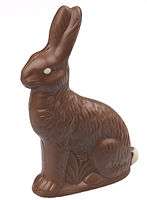Easter Bunny

The Easter Bunny (also called the Easter Rabbit or Easter Hare) is a folkloric figure and symbol of Easter, depicted as a rabbit bringing Easter eggs. Originating among German Lutherans, the "Easter Hare" originally played the role of a judge, evaluating whether children were good or disobedient in behaviour at the start of the season of Eastertide.[1] The Easter Bunny is sometimes depicted with clothes. In legend, the creature carries colored eggs in his basket, candy, and sometimes also toys to the homes of children, and as such shows similarities to Santa Claus or the Christkind, as they both bring gifts to children on the night before their respective holidays. The custom was first mentioned in Georg Franck von Franckenau's De ovis paschalibus[2] (About Easter Eggs) in 1682[3] referring to a German tradition of an Easter Hare bringing Easter eggs for the children.
Symbols

Rabbits and hares
The hare was a popular motif in medieval church art. In ancient times, it was widely believed (as by Pliny, Plutarch, Philostratus, and Aelian) that the hare was a hermaphrodite.[4][5][6] The idea that a hare could reproduce without loss of virginity led to an association with the Virgin Mary, with hares sometimes occurring in illuminated manuscripts and Northern European paintings of the Virgin and Christ Child. It may also have been associated with the Holy Trinity, as in the three hares motif.[4][7] Eggs, like rabbits and hares, are fertility symbols[8] of antiquity. Since birds lay eggs and rabbits and hares give birth to large litters in the early spring, these became symbols of the rising fertility of the earth at the Vernal Equinox.
Rabbits and hares are both prolific breeders. Female hares can conceive a second litter of offspring while still pregnant with the first.[9][10] This phenomenon is known as superfetation. Lagomorphs mature sexually at an early age and can give birth to several litters a year (hence the saying, "to breed like rabbits" or "to breed like bunnies"). It is therefore not surprising that rabbits and hares should become fertility symbols, or that their springtime mating antics should enter into Easter folklore.
Eggs
In addition, Orthodox churches have a custom of abstaining from eggs during the fast of Lent. The only way to keep them from being wasted was to boil or roast them, and begin eating them to break the fast. As a special dish, they would probably have been decorated as part of the celebrations. Later, German Protestants retained the custom of eating colored eggs for Easter, though they did not continue the tradition of fasting.[11] Eggs boiled with some flowers change their color, bringing the spring into the homes, and some over time added the custom of decorating the eggs.[12] Many Christians of the Eastern Orthodox Church to this day typically dye their Easter eggs red,[13] the color of blood, in recognition of the blood of the sacrificed Christ (and, of the renewal of life in springtime). Some also use the color green, in honor of the new foliage emerging after the long-dead time of winter. The Ukrainian art of decorating eggs for Easter, known as pysanky, dates to ancient, pre-Christian times. Similar variants of this form of artwork are seen amongst other eastern and central European cultures.[14]
The idea of an egg-giving hare went to the U.S. in the 18th century. Protestant German immigrants in the Pennsylvania Dutch area told their children about the "Osterhase" (sometimes spelled "Oschter Haws"[15]).[16] Hase means "hare", not rabbit, and in Northwest European folklore the "Easter Bunny" indeed is a hare. According to the legend, only good children received gifts of colored eggs in the nests that they made in their caps and bonnets before Easter.[17]
 A bunny and eggs
A bunny and eggs A chocolate Easter Bunny
A chocolate Easter Bunny.jpg) Chocolate Easter Bunny moulds from Alsace Musée du pain d'épices
Chocolate Easter Bunny moulds from Alsace Musée du pain d'épices
Association with Ēostre
In his 1835 Deutsche Mythologie, Jacob Grimm states "The Easter Hare is unintelligible to me, but probably the hare was the sacred animal of Ostara". This proposed association was repeated by other authors including Charles Isaac Elton [18] and Charles J Billson.[19] In 1961 Christina Hole wrote 'The hare was the sacred beast of Eastre (or Eostre), a Saxon goddess of Spring and of the dawn'.[20] The belief that Ēostre had a hare companion who became the Easter Bunny was popularized when it was presented as fact in the BBC documentary Shadow of the Hare (1993).[21]
The Oxford Dictionary of English Folklore however states "... there is no shred of evidence" that hares were sacred to Ēostre, noting that Bede does not associate her with any animal.[22]
Transformed bird
Sarah Ben Breathnach in Mrs Sharp's Traditions (1990) provides an origin story for the Easter Bunny: "According to legend, Eostre's favorite animal was a large handsome bird, which in a fit of anger she turned into a hare."[23] Another version of this story, in which Ēostre transforms the bird into a hare in an act of mercy, was written by Jean-Andrew Dickmann and appeared in Cricket magazine.[24] Both Breathnach and Dickmann present their respective 'transformed bird' stories as if they were legend, though no earlier version of either has been attested.
See also
- Easter Bilby
- Ēostre
- Mad as a March hare
- Osterfuchs (Easter Fox) (in German)
- Rabbits in the arts
- Rabbits in culture and literature
- The Goose That Laid the Golden Eggs
- Here Comes Peter Cottontail
References
- ↑ Cross, Gary (2004). Wondrous Innocence and Modern American Children's Culture. Oxford University Press. ISBN 0195348133.
- ↑ Franck von Franckenau, Georg (1682). Disputatione ordinaria disquirens de ovis paschalibus / von Oster-Eyern. Satyrae Medicae. XVIII. Heidelberg. p. 6. Retrieved 18 July 2013.
- ↑ Easter Bunny - What Does He Have To Do With Easter?, occultcenter.com
- 1 2 Chapman, Chris (2004). "What does the Symbol Mean?". Three Hares Project. Retrieved 20 April 2014.
- ↑ Marta Powell Harley. "Rosalind, the hare, and the hyena in Shakespeare's As You Like It". Shakespeare Quarterly.
- ↑ "Sir Thomas Browne (1646; 6th ed., 1672) Pseudodoxia Epidemica III:xvii (pp. 162-166)".
- ↑ "Three Hares as representation of the Trinity". Threehares.blogspot.com. 2006-02-25. Retrieved 2010-06-29.
- ↑ Heller, Steven (April 2014). "Seeing Rabbits". Academic Search Complete (Vol. 68 Issue 2).
- ↑ Martinez-Gomez, Margarita (September 2004). "Overlapping litters and reproductive performance in the domestic rabbit". Academic Search Complete (Vol. 82 Issue 4). Physiology & Behavior.
- ↑ Lumpkin, Susan; John Seidensticker (2011). Rabbits: The Animal Answer Guide. JHU Press. ISBN 0-8018-9789-0. p. 122.
- ↑ Shrove Tuesday Pancakes! by Bridget Haggerty - Irish Culture & Customs, World Cultures European, paragraph 5 line 2 refers to the Catholic custom of abstaining from eggs during Lent. Accessed 3/1/08
- ↑ Snodgrass, Lucie L. (March 2005). "DYED IN Tradition". Academic Search Complete (Issue 329). Vegetarian Times.
- ↑ How To Dye Red Eggs with Onion Skins for Greek Easter by Nancy Gaifyllia from Your Guide to Greek Food on About.Com Accessed April 9, 2008
- ↑ Hallett, Vicky (March 31, 2003). "Egg-cellent art". Academic Search Complete (Vol. 134 Issue 10). U.S. News & World Report.
- ↑ "Gruß vom Osterhasen: Oschter Haws Song : GERMAN WORLD MAGAZINE". Germanworldonline.com. 2011-04-23. Retrieved 2013-03-31.
- ↑ "Easter on the Net - The Easter Bunny". Holidays.net. Retrieved 2013-03-31.
- ↑ Easter Symbols from Lutheran Hour Ministries. Accessed 2/28/08
- ↑ Charles Isaac Elton (1890), Origins of English History
- ↑ Charles J Billson (1892), Folk-Lore vol 3 issue 4
- ↑ Christina Hole (1961) Easter and its Customs
- ↑ Attenborough, Sir David (Presenter) (April 12, 1993). Wildlife on One Easter Special Shadow of the Hare (Television). United Kingdom: BBC.
- ↑ Jacqueline Simpson and Stephen Roud (2000), A Dictionary of English Folklore
- ↑ Sarah Ben Breathnach (1990), Mrs Sharp's Traditions: Reviving Victorian Family Celebrations of Comfort and Joy
- ↑ Jean-Andrew Dickmann (2002), The Coming of Eostre, Cricket magazine vol 29 issue 7
External links
| Wikimedia Commons has media related to Easter Bunny. |
- Charles J. Billson. "The Easter Hare". Folk-Lore. Vol. 3, No. 4 (December 1892).